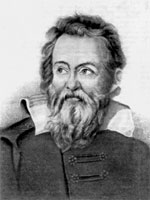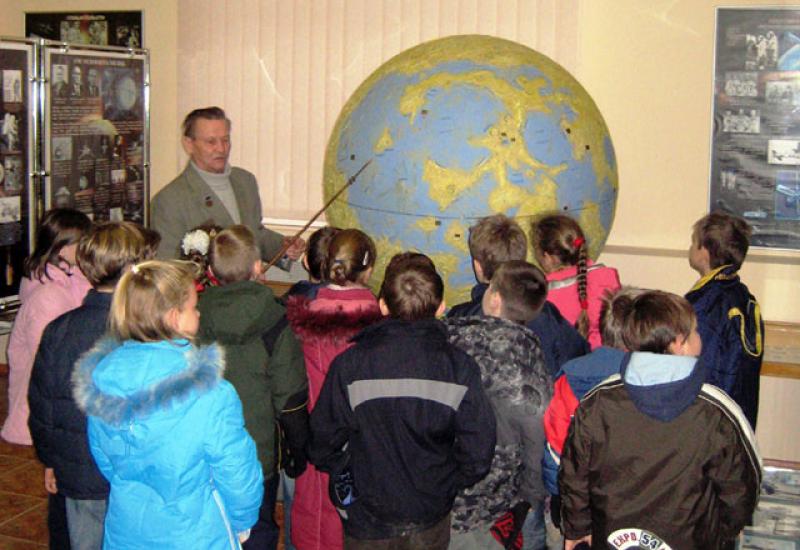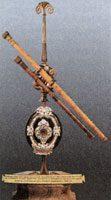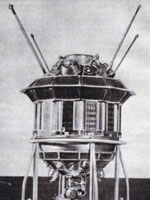There is in the Department of Aviation and Space Museum at the State Polytechnic "KPI", which presents samples of model aviation and space technology, the exhibit, which seems to get here by accident. This is - a big (one and a half meters in diameter) globe of the Moon. It seems that the most appropriate place for it is in a natural museum. However there is some logic in its staying here, because without space technology globe of the Moon can not be created. And the appearance of the visible side of the moon maps was due to the development of surveillance equipment - telescopes.
Month is the nearest to Earth celestial body. On space standards, it is "very close" - at an average distance of 384 thousand km that is only thirty times larger than the diameter of the Earth. For comparison, the closest planet to Earth, Venus is distant more than 100 times more - coming to our planet no closer than 39 million kilometers.
Although people watched the Moon from the immemorial time, and changing phases of the soon are the basis of units of time, like a week and a month, but to draw maps of the moon no one came to mind. Still a very long time people did not see anything in common between the earthly and the heavenly world, which includes the moon planets, stars.
 400 years ago, on January 7, 1610, Galileo Galilei first looked at the night sky in a telescope he created. And he was amazed by what he saw. It turned out that the Milky Way is composed of many stars, around Jupiter little "stars" are revolving and the Moon's surface is not perfectly smooth, as should be according the representations of Aristotle on the heavenly world. This surface is similar to the Earth is covered with huge mountains, deep gorges and precipices. It is interesting to note that Galileo saw it all because he was a supporter of the heliocentric system of Copernicus that the Earth is not the center of the universe, and only is one of the planets and is not fundamentally different from the others. Before Galileo in July 1609 the Moon was observed through a telescope by the Englishman T.Gariot who painted what he saw, but he did not see the mountains. He wrote only that the Moon is like a cake, and did not publish his observations. Realizing the importance of his discoveries, Galileo hastened to report them all - in March 1610 in Venice he published his booklet (32 p.) "The Starry Messenger".
400 years ago, on January 7, 1610, Galileo Galilei first looked at the night sky in a telescope he created. And he was amazed by what he saw. It turned out that the Milky Way is composed of many stars, around Jupiter little "stars" are revolving and the Moon's surface is not perfectly smooth, as should be according the representations of Aristotle on the heavenly world. This surface is similar to the Earth is covered with huge mountains, deep gorges and precipices. It is interesting to note that Galileo saw it all because he was a supporter of the heliocentric system of Copernicus that the Earth is not the center of the universe, and only is one of the planets and is not fundamentally different from the others. Before Galileo in July 1609 the Moon was observed through a telescope by the Englishman T.Gariot who painted what he saw, but he did not see the mountains. He wrote only that the Moon is like a cake, and did not publish his observations. Realizing the importance of his discoveries, Galileo hastened to report them all - in March 1610 in Venice he published his booklet (32 p.) "The Starry Messenger".
It should be noted that at the end of the XVI century, before the invention of the telescope, the first, however, though not very accurate map of the Moon was composed by the British physicist V.Gilbert. In 1619 the astronomer and Jesuit P.Sheyner published the first map of the visible side of the Moon. M..F Van Langree on his map of the Moon in 1628 noted about 200 details and called many of them the names of biblical characters, saints and famous people of the past. But these names are not used now. Modern names of parts of the lunar surface laid in the books "selenography" (1647) Gdańsk astronomer Ya.Gevely, "New Almagest" (1651) Dzh.B. Richchioli. Ya.Gevely used the terms "sea", "swamp", "bay" for the dark spots of different colors and sizes, called some mountain areas of the Moon by Earth names (Alps, Apennines, Carpathians, Caucasus, and others.). Riccioli named many craters (Atlas, Hercules, Dionysus, Isidor et al.).
With the improvement of telescopes, astronomers have created a more detailed maps of the Moon. In the XVIII century new maps were published by the German astronomers and T.Mayer and I.Shreter, in the XIX century – by German astronomers V.Ber and G.Medler (1830-1837), Yu.Shmidt (1878), I.Kriger (1898).
In the XIX century the photography was invented, and it began its applications in astronomy, and it began also a new stage in the study of the Moon. In 1897, the Paris Observatory published the first photographic atlas of the Moon, and in 1904 the American astronomer V.Pikering - second lunar photographic atlas.
But all these maps and atlases depicted only the visible half of the moon. Moon always faces the Earth on one side - revolves around its axis in the same period as that of the Earth and fluctuates slightly around its axis. Therefore, from the Earth it can be seen a bit more than half of the moon's surface - about 59%. But 41% of the lunar surface is completely invisible from the Earth. And to create a globe of the Moon, it will take a revolution in technology.
October 4, 1957 the launch of the Soviet Union's first artificial satellite of the Earth started the space era of humanity. And in 1959 they were started flights to the Moon. January 2, 1959 in the Soviet Union it was launched the automatic interplanetary station (AIS) "Luna-1", which after two days flew near the Moon at a distance of less than 6 thousand km and went into a solar orbit - the first artificial planet of the solar system. March 3, 1959 American station "Pioneer-4" flew a distance of 60 thousand km from the Moon. September 14, 1959 AIC "Luna 2" reached the surface of the moon. October 4, 1959 it was launched AMC "Luna-3" to the Moon. This vehicle was supposed to take a photo of the back side of the moon and send images back to Earth. It should be noted that this date was chosen not by chance. At that time it was impossible to change the orbit of the spacecraft. And so to be able to take a photo of the back side of the moon, the vehicle was supposed to start on a specific day and time once a month.
It was 50 years ago. During this time, technology has changed beyond recognition. Today digital cameras and digital communication became common things. I think readers will be interested to know some technical details of that expedition.
The trajectory of the station chosen so that at the time of the shooting station was approximately on the direct line joining the Sun and the Moon. Before starting the process of photographing, the lower bottom of the station, where solar sensors were installed, was aimed at the sun - with the help of orientation, which included optical and gyroscopic sensors and electronic devices. With this, the window with the camera lenses, was directed on the Moon. After that, the sensors checked orientation by the light reflected from the lunar surface, and gave a command to start photographing. Pictures were taken October 7, 1959 at a distance of 65-68 thousand km from the surface of the Moon on 35 mm film. 2/3 of invisible side of the Moon was photographed as well as part of the visible. Then the film has been processed, fixed and dried with a special device designed to work in a state of weightlessness.
Images on the film with a help of the television camera tube were converted into a radio signal and transmitted to Earth. On Earth, the received signal after amplification and conversion were fixed on magnetic recording devices in, for cathode-ray tubes with long afterglow and electrochemical paper in facsimile equipment. Transferring images for the first time was carried out at a distance of 470 thousand km in slow mode (1 frame per 30 min.). October 18 the re-transmission was held - in fast mode (1 frame per 15 seconds). After this the comminication with the station has been lost.
On the basis of those photographs the USSR Academy of Sciences in 1960 produced and printed the first atlas and map of the reverse side of the moon.
Then came a series of misfortunes. In the years 1962-1964 American AIC "Ranger-3, -4, -5, -6," which aim was to television shooting from a short distance of the Moon, missed the Moon, or fell down on the Moon and broke. The same fate awaited the Soviet AIC "Luna-4, -5, -6." Their task was to carry out a soft landing on the Moon.
American AIC «Ranger-7, 8, 9» from July 1964 to March 1965 performed detailed tele shooting of the Moon. In particular, the latest AIC has received 5800 images from a height of 2300 km to 600 m above the mountainous area in the central part of the visible hemisphere.
July 18, 1965, Soviet AIC "Zond-3" photographed one third side of the Moon, which has not yet been photographed.
Photographing the moon was began at a distance of 11.6 thousand km, and a few days later at a distance of 220 thousand km from the Earth it began transmission of received images. From a distance of 31.5 thousand km the retransmission of the received images was carried out. These images allowed making a more complete map of almost the entire surface of the moon, and finally creating a lunar globe. It is interesting to note that neither in pre-revolutionary Russia, nor in the Soviet Union did not issue cards visible side of the moon. But first globe have been created. that's what it means to be first in space!
After two failures AMC "Luna 7" and "Luna-8", which crash-landed in October and December 1965, AIC "Luna-9" January 31, 1966 carried out a soft landing in the Ocean of Storms and transmits television panoramas of the lunar landscape. A March 31, 1966 on the lunar orbit was launched AIC "Luna-10" - the first artificial satellite of the moon. I should say that the first globe had significant "white spots" near the poles. The lunar orbit satellites filled the spot.
Then the Soviet Union and the United States launched a new AIC - into orbit around the moon, which not only photographed the moon's surface, but also explored its gravitational field and gamma radiation, meteorite situation. Since the 90-ies of twentieth century, Japan, the European Space Agency, China and India started to launch their own research station to the Moon.
Globe Moon, exhibited in the Department of Aviation and Astronautics DPM, was given as a gift by the director of the Zhitomir’s museum named after Korolev, O.A.Kopil. Together with the Museum of Cosmonautics he experienced different times, even "stored" in Kiev Planetarium at the technical level. In 2008, when Space Museum moved to the PDM, the Globe was restored. The names of lunar objects, designated landing site of automatic stations and landing people on the moon were written on it.
Globe of the moon is of great interest to visitors of the museum, especially when the guides show the reverse side of the Moon, which is significantly different from the visible side. Go to the Department of Aviation and Astronautics and look closely at what people for many centuries could not see!



